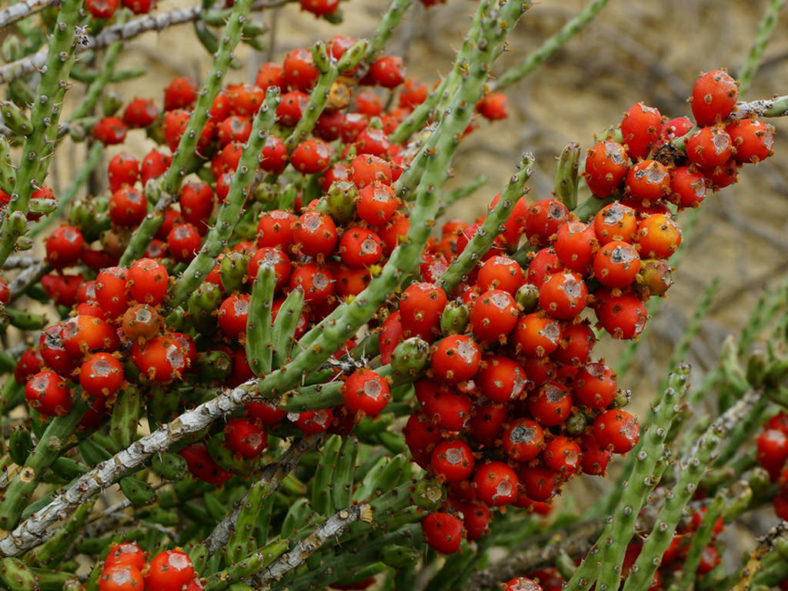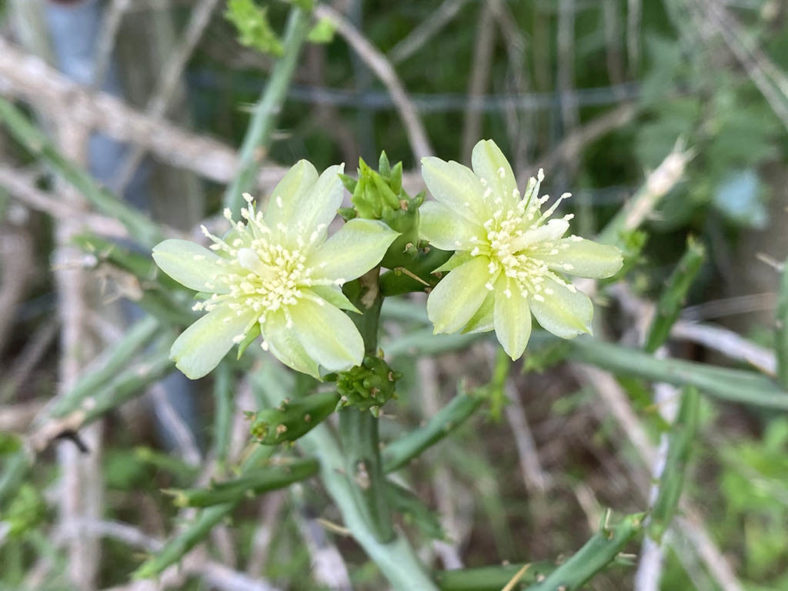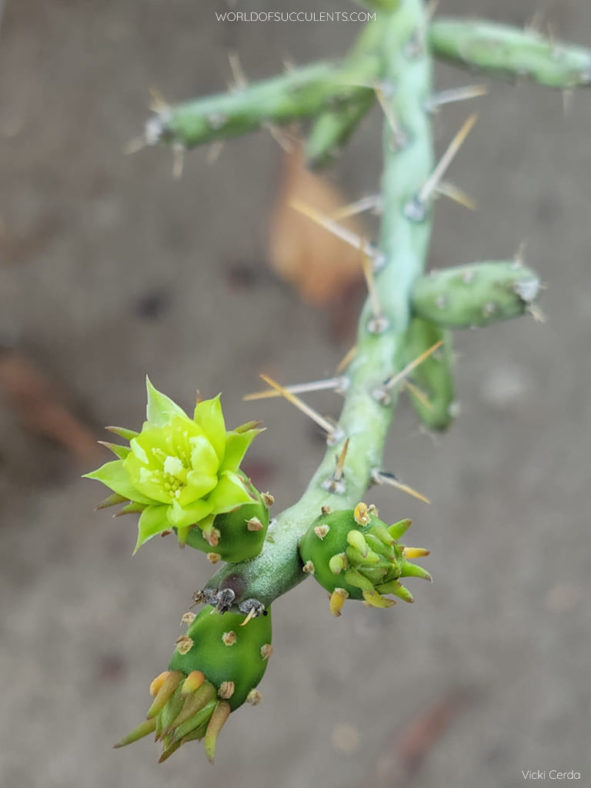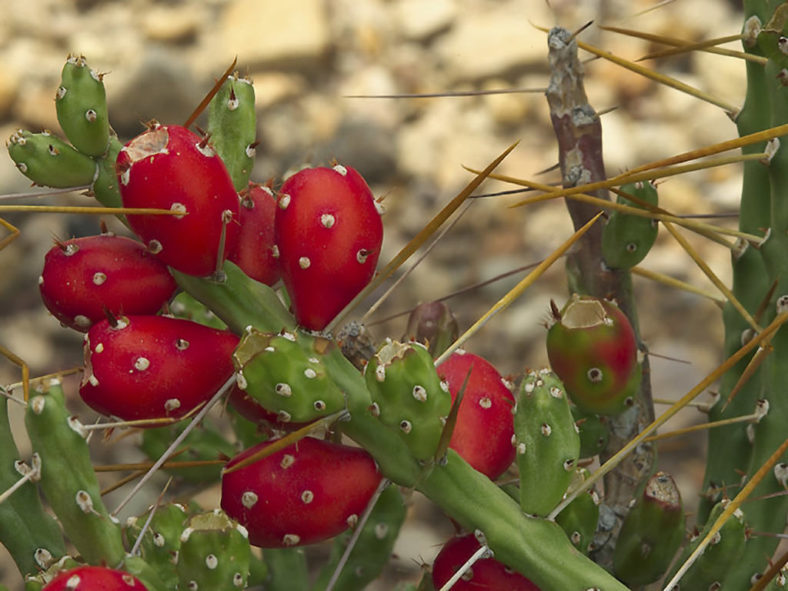Scientific Name
Cylindropuntia leptocaulis (DC.) F.M.Knuth
Common Name(s)
Desert Christmas Cactus, Desert Christmas Cholla, Pencil Cactus, Pencil Cholla, Tesajo Cactus, Christmas Cactus, Christmas Cholla, Rattail Cactus, Slender-stem Cactus, Turkey Cactus, Turkey Pear, Tasajillo (Spanish)
Synonym(s)
Cylindropuntia leptocaulis var. leptocaulis, Grusonia leptocaulis, Opuntia leptocaulis
Scientific Classification
Family: Cactaceae
Subfamily: Opuntioideae
Tribe: Cylindropuntieae
Genus: Cylindropuntia
Etymology
The specific epithet "leptocaulis" (pronounced "lep-toh-KAW-liss") means "thin-stemmed, slender-stemmed" and refers to the slender branches of this species.
Origin
Cylindropuntia leptocaulis is native to the United States (Arizona, New Mexico, Oklahoma, and Texas) and Mexico (Sonora, Chihuahua, Coahuila, Nuevo León, Durango, Tamaulipas, and Zacatecas). It grows on sandy, loamy, or gravelly soils in deserts, grasslands, chaparral, woodlands, flats, bajadas, and slopes at elevations between 130 and 4,920 feet (40 and 1,500 m).
Description
Cylindropuntia leptocaulis is a sparingly to densely branched cactus with slender branches that bear many short, commonly spineless branchlets arranged mostly at right angles. It can grow up to 6 feet (1.8 m) tall, usually as an erect shrub or sometimes as a small tree with a trunk measuring up to 4 inches (10 cm) in diameter. The stem segments are gray-green or purplish, cylindrical, with linear tubercles that look like elongated wrinkles when dried. They can reach up to 3.2 inches (8 cm) in length and 0.25 inches (0.6 cm) in diameter. The spines are absent or mostly in apical areoles of the main branches, usually one, but occasionally up to 3 per areole. They are straight or arching, red-brown with grey-white coating and yellow at the tip, and can grow up to 1.8 inches (4.5 cm) long. There are also a few small yellow or reddish-brown glochids. The woolly areoles are white to yellow, becoming gray with age.
The flowers are funnel-shaped, pale yellow to greenish-yellow, sometimes tipped red, and can reach up to 1 inch (2.5 cm) in length (including ovary) and 0.8 inches (2 cm) in diameter. The fruits are fleshy, smooth or covered in minute glochids, red, occasionally yellow, and contain pale-yellow seeds. They are obovate and can grow up to 1.2 inches (3 cm) long and 0.5 inches (1.2 cm) in diameter.

How to Grow and Care for Cylindropuntia leptocaulis
Light: C. leptocaulis thrives in full sun. Indoors, a window with access to sunlight for 6 hours a day works best. Some shade during midday and afternoon can prevent sunburn in very hot climates.
Soil: This cactus requires a well-draining soil mix. It prefers sandy or gravelly soil but can tolerate other soil types if there is good drainage. Use a commercial cactus potting mix, or create your own.
Temperature: Extremely tolerant of high temperatures, this cactus prefers cooler temperatures in winter. C. leptocaulis can withstand temperatures as low as 25°F (-3.9°C). USDA Plant Hardiness Zones 9b to 11b, 25°F to 50°F (-3.9°C to 10°C).
Watering: From spring to fall, water moderately and let the soil dry out completely before watering again. In most areas, rainfall will be enough for established plants. For a potted plant, never let the container sit in water. Suspend watering in winter.
Fertilizing: C. leptocaulis does not need fertilizer when planted in the ground. However, it will benefit from fertilizing during the growing season if grown in a container. Apply a water-soluble fertilizer. Suspend feeding during the winter when the plant goes dormant.
Repotting: Repot only when your C. leptocaulis becomes potbound or is too large and unstable in its container. Choose a slightly larger container with drainage holes at the bottom. The best time for repotting is late winter or early spring.
Propagation: You can propagate C. leptocaulis by cuttings (stem segments) or seeds. Starting this cactus from seeds is a slow process, and it may take 3 to 4 years before you have a substantial plant. Propagation by stem segments is the easiest method and yields faster results. The best time to take cuttings is early summer. Sow the seeds in late spring.
Learn more at How to Grow and Care for Opuntia.
Toxicity of Cylindropuntia leptocaulis
C. leptocaulis is not toxic to humans or pets. However, it is best kept away from pets and children as its glochids may cause moderate skin irritation.
Links
- Back to genus Cylindropuntia
- Succupedia: Browse succulents by Scientific Name, Common Name, Genus, Family, USDA Hardiness Zone, Origin, or cacti by Genus
Photo Gallery
Click on a photo to see a larger version.


